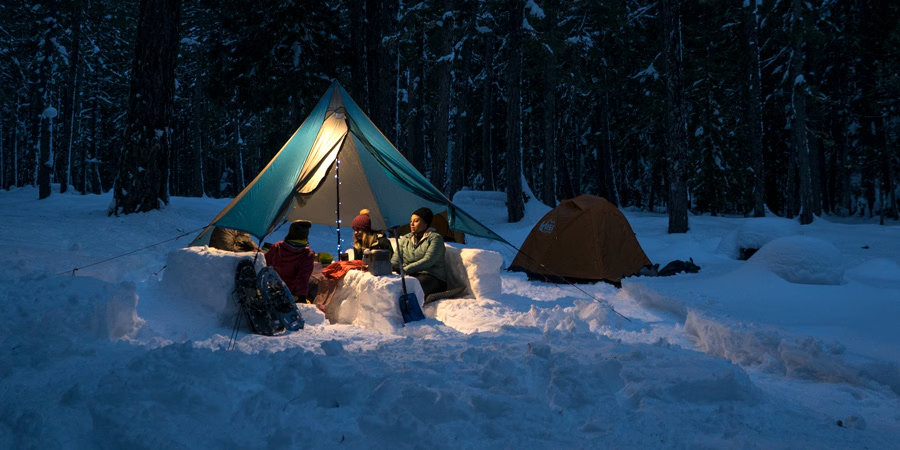Winter camping transforms familiar landscapes into pristine wonderlands, but it demands careful preparation and specialized gear. As temperatures plummet, your margin for error shrinks, making proper equipment and knowledge essential for both comfort and safety.
In this comprehensive guide, we'll explore the essential gear and techniques that will keep you warm and safe during sub-zero adventures in the Canadian wilderness.
The Four-Season Shelter: Your Winter Fortress
Your tent becomes your sanctuary in winter conditions. Unlike three-season tents, four-season models feature stronger poles, more robust fabrics, and less mesh to retain heat and withstand snow loads.
Recommended Four-Season Tents
- MSR Access 2 - Lightweight yet durable, perfect for ski touring
- Big Agnes Copper Spur HV UL2 Bikepack - Excellent balance of weight and space
- Snow Peak Alpha Breeze - Spacious with exceptional weather protection
When setting up your winter camp, look for natural windbreaks and avoid avalanche-prone areas. Pack down the snow where you'll pitch your tent to create a stable platform, and use all available guylines to secure your shelter against winter winds.
Mastering the Sleep System
Staying warm through the night requires a carefully calibrated sleep system. Your sleeping bag should be rated at least 10°F (-12°C) lower than the expected temperatures.
Pro Tip: The Sleeping Bag Rating Myth
Manufacturer temperature ratings indicate survival limits, not comfort. For comfortable sleep, choose a bag rated 10-15°F lower than your expected minimum temperature.
Combine your sleeping bag with an insulated sleeping pad with an R-value of at least 4.0. The ground conducts heat away from your body much faster than the air, making ground insulation critical.
Layering: The Art of Staying Warm
The key to staying warm in winter conditions is mastering the layering system. This approach allows you to regulate your temperature by adding or removing layers as activity levels and conditions change.
Base Layer: Moisture Management
Start with a moisture-wicking base layer made of merino wool or synthetic materials. Avoid cotton, which retains moisture and can lead to dangerous heat loss.
Mid Layer: Insulation
Your mid-layer provides the primary insulation. Fleece jackets or lightweight down/synthetic insulated jackets work well for active use, while heavier insulated jackets are essential for camp wear.
Outer Layer: Weather Protection
A waterproof and breathable shell protects against wind, snow, and rain. Look for features like powder skirts, adjustable hoods, and ample ventilation options.
Don't Forget Extremities
- Head: 40% of body heat is lost through the head - wear a warm hat
- Hands: Use liner gloves under insulated mittens for dexterity
- Feet: Wool or synthetic socks with insulated waterproof boots
Winter Cooking and Hydration
Staying hydrated and well-fed is crucial in cold weather. Your body burns more calories to stay warm, and proper hydration helps prevent hypothermia.
Preventing Water Freeze
Store water bottles upside down (ice forms at the top first). Use insulated bottle covers and consider keeping a water bottle in your sleeping bag overnight.
White gas stoves outperform canister stoves in cold conditions. If using canister stoves, warm the canister in your jacket before use and consider a winter-specific model with a pre-heat tube.
Safety Considerations for Winter Camping
Winter conditions introduce additional hazards that require specific preparation and knowledge:
- Avalanche awareness: Check forecasts and carry appropriate safety gear if traveling in avalanche terrain
- Navigation: Trails disappear under snow - carry map, compass, and GPS with extra batteries
- Emergency shelter: Always carry materials for an emergency bivouac
- Communication: Satellite messengers provide critical backup in areas without cell service
"The winter camper's motto should be 'hope for the best, prepare for the worst.' Proper preparation turns potentially dangerous conditions into manageable challenges and opens up incredible wilderness experiences."
Final Thoughts
Winter camping offers solitude and beauty that few other experiences can match. With the right gear, knowledge, and respect for the conditions, you can safely enjoy the magic of the winter wilderness. Start with shorter trips close to home to build your skills and confidence before venturing into more remote areas.
Remember that turning back is always an option. The mountains will be there another day, and there's no shame in postponing an adventure when conditions become unsafe.
Back to All Articles